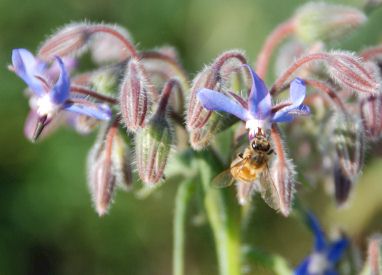Ode to Borage - The flower of courage
/In my attempts to write about companion planting, my musings which began so simply started to twist and turn, passing through plants that are friends, feeding the soil, beneficial insects, deterring insects, attracting wildlife, brightening the soul, curing ailments, making ecosystems... As I sought to stay on one tangent, I realized that maybe the best way to approach such a huge topic is by paying homage each week to one special plant and its relationship in our garden- And so I bring you, my plant of the week... Ode to Borage The Flower of Courage
With its bright blue, star shaped flowers that uplift their heads, blooming in our climate from late winter through to late autumn, borage brightens any garden and gardener. Borage was used to promote bravery on the jousting field and continues to be used to bestow courage. Borage has a relaxing effect generally and is said to dispel grief and sadness (75, McIntyre). The herbalist Gerard writing in 1597 said that a syrup of borage flowers 'comforteth the heart, purgeth melancholy and quieteth the phrenticke and lunatick person.' For as the lion finds out, where does courage lie but in the heart.
Being an edible flower, borage brightens a salad, livens up a simple glass of water and makes beautiful cake decorations. In ayurveda, borage has a sweet, astringent taste and a cooling action (Lad, 195). The crushed leaves smell like cucumber. Young leaves contain vitamin C and can be added to a salad. Borage flowers are a wonderful addition to a birthing woman's bouquet and a soothing bath.
 The blue colour attracts bees, and as they are blooming from late winter, they are excellent to put near your fruit trees. Most apple, pear, sweet cherry and plum trees cannot produce fruit from their own pollen. They require the lovely aid of the bee to take pollen from one tree to another, providing the cross pollination necessary. In addition to fruit trees, strawberries flourish near a borage plant as do tomatoes and squash. Borage deters tomato hornworm and cabbage worms.
The blue colour attracts bees, and as they are blooming from late winter, they are excellent to put near your fruit trees. Most apple, pear, sweet cherry and plum trees cannot produce fruit from their own pollen. They require the lovely aid of the bee to take pollen from one tree to another, providing the cross pollination necessary. In addition to fruit trees, strawberries flourish near a borage plant as do tomatoes and squash. Borage deters tomato hornworm and cabbage worms.
Borage roots go down 2 metres, mining the subsoil for nutrients and adding organic matter (Woodrow, 147). It accumulates silica, potassium and calcium, makes good mulch and is a great compost ingredient. As we started this garden on a sand dune very deficient in trace minerals and humus, borage has helped us build a well balanced top soil.
Externally, the fresh juice from the leaves can be applied to burns and to draw out poisons from insect bites, stings or boils.
Boarge self-seeds easily. It is extremely hardy, growing in shade, sun, wet or dry, but the plants are easy to remove from places where they are not welcome, so it doesn’t become a troublesome weed (Woodrow, 147).
The multifunctional quality of adding borage to our garden has been incredible. Our soil is being enriched, the plants are healthier and happier, the garden is prettier, the fruit more prolific, our stings have been soothed and our spirit is continually uplifted. As I sit amidst a sea of borage, calendula and fruit tree blossoms, watching funny little wasps and bees that flit through the flowers, I give my gratitude to this lovely plant and marvel at the beauty of the natural world working harmoniously.
Flower Teas - from Deb Soule
Drinking a tea of any of the following herbs serves to uplift your spirit, gladden your heart, and nourish your nervous system.
Heartsease pansy flowers- 1 part Sacred basil leaves and flowers - 2 parts Borage flowers- 1 part Lemon balm flowers and leaves - 2 parts Lavender flowers- 2 parts
Dose and Use: To make a summer tea, place whatever proportions of these fresh herbs or others you have into cool water and let them infuse in the sunlight or moonlight or slowly heat to near boiling and steep, covered, ten minutes. Drink 2-4 cups a day.
You can also add any of these herbs to an herbal bath. As Rosemary Gladstar says, "Herbal bathing can be soothing to a weary soul. It is a bit hard to remain depressed for long while soaking in a flower-strewn tub surrounded by plants from your garden."
-Family Herbal by Rosemary Gladstar, Gaia's Garden by Toby Hemenway, The Yoga of Herbs by Vincent Lad, The Complete Floral Healer by Anne McIntyre, The Roots of Healing by Deb Soule, How to make a Forest Garden by Patrick Whitefield, The Permaculture Home Garden by Linda Woodrow















